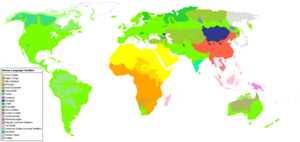Bundar: Bolí
DrustírástíA language is a system of symbols, generally known as lexemes, and the rules by which they are manipulated. The word language is also used to refer to the whole phenomenon of language, i.e., the common properties of languages. Though language is commonly used for communication, it is not synonymous with it. The scientific study of language, its historical development, characteristics, and use in society is known as Linguistics. Human language is a natural phenomenon, and language learning is instinctive in childhood. In their natural form, human languages use patterns of sound or gesture for the symbols in order to communicate with others through the senses. Though there are thousands of human languages, they all share a number of properties from which there are no known deviations. Humans have also invented (or arguably in some cases discovered) many other languages, including constructed human languages such as Esperanto or Klingon, programming languages such as Python or Ruby, and various mathematical formalisms. These languages are not restricted to the properties shared by natural human languages. Cáindárí
Gicená foŧúBolízánt
The International Phonetic Alphabet (IPA) is a system of phonetic notation devised by linguists. It is intended to provide a standardized, accurate and unique way of representing the sounds of any spoken language, and is used, often on a day-to-day basis, by linguists, speech pathologists and therapists, foreign language teachers, lexicographers, and translators. In its unextended form (as of 2005) it has approximately 107 base symbols and 55 modifiers.
Baŕáhí itting xuáisa?
Niviştánk ákBaloc ná bolík: Balocí, Bráhuí, Siráikí, Khetrání, Lásí Drávaŕí bolík: Támil, Maláyálam, Telugú, Kánađ, pen... Amsáya bolík: Sindí, Paşto, Panjápí, Urdú Eşíá ná bolík: Arabí, Bangálí, Cíní, Jápání, Abrání (Hebrew), Indí (Hindi), Koríáí, Mangolíáí, Fársí, Sanskrit, Tibbatí, Táí, Turkí, Vetnámí pen... Yúrap ná bolík: Básk, Cek, Angrezí (English), Fránsí, Jarman, Itálví, Nárvejí, Purtugálí, Romání, Rúsí, Slovek, Ispení, pen... Joŕ karoká bolík: Esperanto, Ido, Volapük, pen... Joŕ karoká (Constructed) bolí, Kríol (Creole), Gum maroká (Extinct) bolí, Laeja (Dialect), Miyánustumání (International) bolí, Rájí (National) bolí, Pidgin, Nişán (Sign) bolí Báşágal ák: Arabí báşágal, Saerillik (Cyrillic) báşágal, Abrání (Hebrew) báşágal, Látíní (Latin) báşágal, pen... Elo likvaŕ ák: Abjad, Abugida, Braille, Hieroglyphics, Logogram, Syllabary, SignWriting pen.. Pen ubbo: Bolí, Bolí ná táríx, Bolízánt, Bolízántkár, Báşágal ná táríx, script Xáot ákElo bundar ák |









